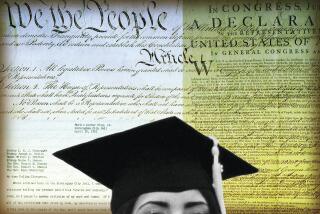Take back the liberal arts
If recent trends hold true, most of the 3 million freshmen starting at U.S. colleges this fall will choose majors that prepare them for careers rather than majors in the liberal arts. Department of Education data show that students are opting for engineering, education or criminology instead of more traditional majors such as history, philosophy or even mathematics. Part of the trend can be explained by students seeking degrees that will allow them to step into jobs upon graduating. But that is only part of the reason for the eclipse of the liberal arts.
Liberal arts scholars are mourning the shift. In her book âNot for Profit: Why Democracy Needs the Humanities,â University of Chicago philosopher Martha Nussbaum argues that pondering Plato, Shakespeare and Darwin cultivates âcitizens who can think for themselves, criticize tradition and understand the significance of another personâs suffering and achievements.â
That may be true. But in visiting university classes across the country, we were appalled at how the humanities and social sciences â even pure sciences â were being taught. If students are staying away from those classes, itâs not necessarily because they prefer practical training. Many times itâs because professors have subverted the subjects that once held pride of place on most campuses.
The liberal arts have been radically altered, both in format and function. The catalog labels are still recognizable: psychology, comparative literature, English and the like. But what is being taught is no longer attuned to undergraduates looking for a broader and deeper understanding of the world.
Consider Yaleâs description of a course it offered that dealt with how disabilities are depicted in fiction: âWe will examine how characters serve as figures of otherness, transcendence, physicality or abjection. Later may come examination questions on regulative discourse, performativity and frameworks of intelligibility.â
Classes like these suggest that professors are using the curriculum as their personal playgrounds. Harvardâs Harvey Mansfield worries that too many professors take the approach that âwhat theyâre doing research on is exactly what students need to know.â As a result, freshmen are often addressed as if they were novitiate doctoral candidates, eager to imbibe the esoterica of academic disciplines. Courses should be created for the benefit of students, not as vehicles for faculty careers.
In our own teaching, weâve found that students arrive at college interested in the economy, their society and its culture. They are not incurious, as many academics complain. Nor do we agree with Charles Murray, who argues we are sending too many young people to college. On the contrary, we believe that every undergraduate, even those now basically majoring in beer, would benefit from giving a seminar paper on Jane Austenâs âPersuasion.â
In less discipline-bound days, professors such as C. Wright Mills, David Riesman and Margaret Mead conversed with their students as they did with larger audiences. The late Allan Bloom mesmerized generations of undergraduates as he paced puffing a Gauloise while holding forth on Rousseauâs âĂmile.â He was a philosopher by training, but he believed that students should be exposed to the broad sweep of great literature and big thoughts.
Cornellâs Robert Frank was speaking about the discipline of economics when he worried that todayâs introductory courses are âtailored not for the majority of students for whom it will be their only economics course, but for the negligible fraction who will go on to become professional economists.â But much the same can be said of sociology, psychology and political science as they are taught in todayâs institutions of higher learning.
Amherst once had a college-wide course called âEvolution of the Earth and Man,â team taught by faculty from geology through genetics. It was exactly the sort of thing that drew people into the sciences. However, that offering no longer exists. Such classes donât earn points for the professors who plan them. Instead, they are expected to be doing research that will lead to tenure or higher ranks, which often means they are concentrating on ever more obscure topics.
An American Mathematical Society study of introductory courses found that only 11% were taught by regular faculty. Professors making their mark in âorbit structure of diffeomorphims of manifoldsâ feel their talents would be wasted teaching Math 101. But they might mull Albert Einsteinâs words to young researchers: âYou do not really understand something unless you can explain it to your grandmother.â
There are still colleges where the contents of the bottles match the labels. But they tend to be more modest schools, ones that donât expect their faculties to make national reputations in research. Occidental College in Los Angeles is such a school, as is Hendrix College in Arkansas and the new Quest University Canada in British Columbia. And there are excellent dedicated liberal arts colleges within affordable public systems. New College of Florida and St. Maryâs College of Maryland are two; also Arizona State Universityâs Barrett honors college and Macaulay Honors College at the City University of New York, which waives tuition for students who maintain a 3.5 grade-point average.
As high school students and their parents consider college options, they might want to take a careful look at catalogs and course descriptions. In higher education these days, itâs buyer beware.
Andrew Hacker and Claudia Dreifus are the authors of âHigher Education?â which came out in paperback this month.
More to Read
A cure for the common opinion
Get thought-provoking perspectives with our weekly newsletter.
You may occasionally receive promotional content from the Los Angeles Times.










